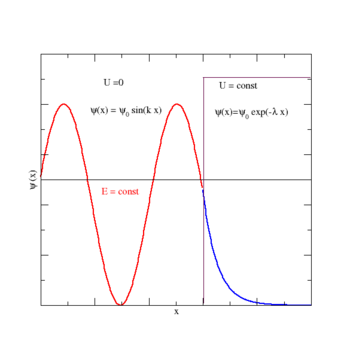Quantum tunneling
|
|
Quantum tunneling is the quantum-mechanical effect of transitioning through a classically-forbidden energy state. The classical analogy is for a car on a roller coaster to make it up and over a hill which it does not have enough kinetic energy to surmount.
The classical explanation (http://www.physicspost.com/imageview.php?imageId=184) is as follows:
There's always a probability of an electron being in a remote location such as ten meters in front (we'll say for now). What prevents this electron from existing in this area is a 'barrier' of potential energy (an electric field, to be exact) greater than that of the electron's kinetic energy. If this potential energy were to be significantly lowered to a level lesser than that of the kinetic energy, the probability of the electron's existence in this remote location is now much greater, and may become possible. It would then cease existence in its current location, and exist in the remote location.
One of the major applications is in electron-tunneling microscopes (see scanning tunneling microscope) used to see objects that are too small to see using conventional microscopes. Electron tunneling microscopes overcome the limiting effects of conventional microscopes (optical aberrations, wavelength limitations) by scanning the surface of an object with tunneling electrons.
Tunneling is a source of major current leakage in Very-large-scale integration (VLSI) electronics. This results in the substantial power drain and heating effects that plague high-speed and mobile technology.
External link
- Quantum Tunneling Simulation at Visual Quantum Mechanics (http://phys.educ.ksu.edu/vqm/html/qtunneling.html)da:Kvantemekanisk tunnelering
de:Tunneleffekt fr:Effet tunnel nl:Tunneleffect pl:Zjawisko tunelowe ru:Туннельный эффект

